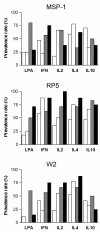Cellular immune response to Plasmodium falciparum after pregnancy is related to previous placental infection and parity
- PMID: 12495437
- PMCID: PMC149387
- DOI: 10.1186/1475-2875-1-16
Cellular immune response to Plasmodium falciparum after pregnancy is related to previous placental infection and parity
Abstract
Background: Malaria in pregnancy is characterised by the sequestration of Plasmodium falciparum-infected erythrocytes in placental intervillous spaces. Placental parasites express a specific phenotype, which allows them to cytoadhere to chondroitin sulfate A expressed by syncytiotrophoblasts. Malaria infection during pregnancy allows the acquisition of antibodies against placental parasites, these antibodies are thought to be involved in protection during subsequent pregnancies.
Methods: To investigate the development of a cellular response to placental parasites during pregnancy, peripheral blood mononuclear cells were collected from women at the time of their confinement. The study was performed in Cameroon where malaria transmission is perennial. In vitro cell proliferation and cytokine production were measured in response to non-malarial activators (concanavalin A and PPD), a recombinant protein from P. falciparum MSP-1, and erythrocytes infected by two P. falciparum lines, RP5 and W2. Like placental parasites, the RP5 line, but not W2, adheres to chondroitin sulfate A and to syncytiotrophoblasts.
Results: The proliferative response to all antigens was lower for cells obtained at delivery than 3 months later. Most interestingly, the cellular response to the RP5 line of P. falciparum was closely related to parity. The prevalence rate and the levels of response gradually increased with the number of previous pregnancies. No such relationship was observed with W2 line, or MSP-1 antigen.
Conclusions: This suggests the occurrence of an immune response more specific for the RP5 line in women having had multiple pregnancies, and who are likely to develop immunity to pregnancy-associated parasites. Both humoral and cellular mechanisms may account for the lower susceptibility of multigravidae to malaria.
Figures



References
-
- McGregor IA. Epidemiology, malaria and pregnancy. Am J Trop Med Hyg. 1984;33:517–25. - PubMed
-
- Brabin B. An assessment of low birthweight risk in primiparae as an indicator of malaria control in pregnancy. Int J Epidemiol. 1991;20:276–83. - PubMed
-
- Fried M, Duffy PE. Adherence of Plasmodium falciparum to chondroitin sulfate A in the human placenta. Science. 1996;272:1502–4. - PubMed
-
- Buffet PA, Gamain B, Scheidig C, Baruch D, Smith JD, Hernandez-Rivas R, Pouvelle B, Oishi S, Fujii N, Fusai T, et al. Plasmodium falciparum domain mediating adhesion to chondroitin sulfate A: A receptor for human placental infection. Proc Natl Acad Sci USA. 1999;96:12743–8. doi: 10.1073/pnas.96.22.12743. - DOI - PMC - PubMed
Publication types
MeSH terms
Substances
Grants and funding
LinkOut - more resources
Full Text Sources
Research Materials

